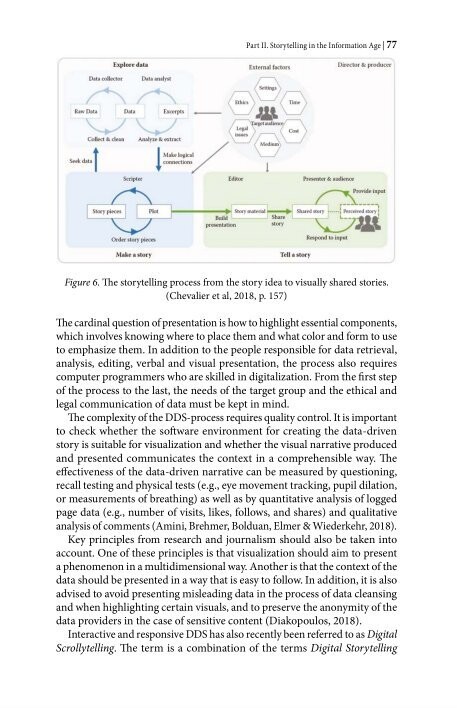

OCR
Part II. Storytelling in the Information Age [ 77 Explore data External factors Director & producer Data collector Data analyst Settings Ethics Time Raw Data Data Excerpts 6 22 4 Target audience, Legal Cost issues Collect & clean Analyze & extract / Medium + Make logical ff Seek data connections „/ ‘ l x Scripter Editor Presenter & audience rm ee input polos Story pieces Plot ET Story material ei» Shared story }- = Perceiv 3 story Build Share szo — sa presentation story 228 Order story pieces to input Make a story Tell a story Figure 6. The storytelling process from the story idea to visually shared stories. (Chevalier et al, 2018, p. 157) The cardinal question of presentation is how to highlight essential components, which involves knowing where to place them and what color and form to use to emphasize them. In addition to the people responsible for data retrieval, analysis, editing, verbal and visual presentation, the process also requires computer programmers who are skilled in digitalization. From the first step of the process to the last, the needs of the target group and the ethical and legal communication of data must be kept in mind. The complexity of the DDS-process requires quality control. It is important to check whether the software environment for creating the data-driven story is suitable for visualization and whether the visual narrative produced and presented communicates the context in a comprehensible way. The effectiveness of the data-driven narrative can be measured by questioning, recall testing and physical tests (e.g., eye movement tracking, pupil dilation, or measurements of breathing) as well as by quantitative analysis of logged page data (e.g., number of visits, likes, follows, and shares) and qualitative analysis of comments (Amini, Brehmer, Bolduan, Elmer & Wiederkehr, 2018). Key principles from research and journalism should also be taken into account. One of these principles is that visualization should aim to present a phenomenon in a multidimensional way. Another is that the context of the data should be presented in a way that is easy to follow. In addition, it is also advised to avoid presenting misleading data in the process of data cleansing and when highlighting certain visuals, and to preserve the anonymity of the data providers in the case of sensitive content (Diakopoulos, 2018). Interactive and responsive DDS has also recently been referred to as Digital Scrollytelling. The term is a combination of the terms Digital Storytelling
Structural
Custom
Image Metadata
- Image width
- 1831 px
- Image height
- 2835 px
- Image resolution
- 300 px/inch
- Original File Size
- 1.08 MB
- Permalink to jpg
- 022_000040/0077.jpg
- Permalink to ocr
- 022_000040/0077.ocr
